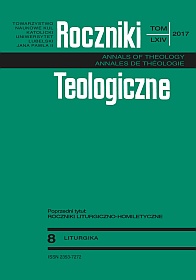Commemoration of All the Faithful Departed and Choice of Mass Readings
Abstract
Prayers for the dead were widespread in the Church in the patristic period and were united with the Eucharist celebrated on particular days. At the end of 10th century or at the beginning of the 11th century, they began to celebrate the Divine Office and the Eucharist for All the Faithful Departed. First, it was in the Benedictine Abbey of Cluny—the celebration was established on November 2. Before the Council of Trent they could choose the readings of Mass from several that were proposed. In the Missal of Pius V, there were established readings. Since 1915, every priest may celebrate three Masses on this day. The Latin Lectionary promulgated after Vatican II proposes the choice of readings from more than forty of the Masses for the dead. The Lectionary in the Polish language has a stable nine readings for three Masses. In other countries, there are large differences in the choice of readings. The principal theme of the biblical texts is the Paschal mystery surrounding the death, resurrection and eternal life of Christ and all the faithful.
References
Amalarius Metensis: De ecclesiasticis officiis. PL 105, 815-1340. Pol.: Amalariusz z Metzu, Święte obrzędy Kościoła, przekład zbiorowy pod red. Tadeusza Gaci, (Dzieła I), Lublin: TN KUL 2016.
Benedykt XVI: Adhortacja apostolska Verbum Domini. Rzym 2010.
Canadian Conference of Catholic Bishops: The Roman Missal. Revised by decree of the second Vatican Council and published by authority of Pope Paul VI. Lectionary Sundays and Solemnities, t. I, Ottawa 1992.
Candidus Fuldendis: Vita S. Eigilis. PL 105, 383-402.
Decyk Jan: Ludzki i Boży wymiar śmierci w świetle kultu zmarłych. Studium liturgiczne. Warszawa: UKSW, 2000.
Decyk Jan: Rzeczywistość eschatyczna człowieka według modlitw za zmarłych Mszału rzymskiego Pawła VI. Studium liturgiczno-teologiczne, Warszawa: Wydawnictwo ATK 1995.
Der grosse Wochentags – Schott, t. 2: 14. bis 34. Woche im Jahreskreis. Originaltexte der authentischen deutschen Ausgabe des Messbuchs und des Lektionars. Freiburg-Basel-Wien 1976.
Isidorus Hispalensis: Regula monachorum. PL 83, 867-894.
Jotsaldus: Vita S. Odilonis. PL 142, 895-940.
Konecki Krzysztof: Teologia liturgii Mszy za zmarłych, w: Mszał księgą życia chrześcijańskiego, red. Bugusław Nadolski, Poznań: Księgarnia św. Wojciecha 1986, s. 207-234.
Konstytucje apostolskie, tł. Stanisław Kalinkowski, w: Synody i Kolekcje Praw, t. II, oprac. Arkadiusz Baron, Henryk Pietras, (Źródła Myśli Teologicznej 42), Kraków: Wydawnictwo WAM 2007.
Kudasiewicz Józef: Słowo Boże w nowych obrzędach pogrzebu, „Ruch Biblijny i Liturgiczny” 27 (1974), s. 41-53.
Labudda Alfons: Dzień Zaduszny, w: Encyklopedia katolicka, t. 4, Lublin: TN KUL 1983, kol. 594-595.
Labudda Alfons: Liturgia Dnia Zadusznego w Polsce do wydania Rytuału Piotrkowskiego (1631) w świetle ksiąg liturgicznych. Studium historyczno-liturgiczne, w: Studia z dziejów liturgii w Polsce, red. Marian Rechowicz, Wacław Schenk, Lublin: TN KUL 1973, s. 301-385.
Labudda Alfons: Msza za zmarłych, „Ruch Biblijny i Liturgiczny” 27 (1974), s. 29-41.
Leclercq Henri: Défunts, w: Dictionnaire d’archéologie chrétienne et de liturgie, t. 4, Paris: Librairie Letouzey et Ane 1920, kol. 428-456.
Leclercq Henri: Toussaint et Trépassés, w: Dictionnaire d’archéologie chrétienne et de liturgie, t. 15, Paris: Librairie Letouzey et Ane 1950, kol. 2677-2681.
Lekcjonarz mszalny, t. I: Okres Adwentu i okres Narodzenia Pańskiego, Poznań: Pallottinum 2015.
Lekcjonarz mszalny, t. IV: Czytania w Mszach o świętych, Poznań: Pallottinum 2004.
Messalino quaotidiano domenicale-festivo e feriale, Milano: San Paolo 1996.
Messalino quotidiano dell’assemblea. Tempo ordinario settimane 8-34, t. II, Bologna: EDB 1991.
Misal Noviembre del 2016. http://laverdadcatolica.org/MisalNoviembre2016.htm (dostęp 23.12. 2016).
Missale Romanum ex decreto Sacrosancti Concilii Tridentini restitutum s. Pii V Pontificis Maximi jussu editum, aliorum Pontificum cura recognitum, a Pio X reformatum et Benedicti XV auctoritate vulgatum, Romae–Tornaci–Parisiis 1950.
Missale Romanum ex decreto Sacrosancti Concilii Tridentini restitutum s. Pii V Pontificis Maximi jussu editum Clementis VIII. et Urbani VIII. auctoritate recognitum, Editio Ratisbonensis duodecima, Ratisbonae 1878.
Missale Romanum ex decreto Sacrosancti Oecumenici Concilii Vaticani II instauratum auctoritate Pauli Pp. VI promulgatum, Editio typica, Typis Polyglottis Vaticanis 1970.
Missale Romanum ex decreto Sacrosancti Oecumenici Concilii Vaticani II instauratum auctoritate Pauli Pp. VI promulgatum. Lectionarium III Pro Missis de Sanctis, ritualibus, ad diversa, votivis et defunctorum, Editio typica, Typis Polyglottis Vaticanis 1972.
Missel de semaine, présenté par Pierre Jounel, Texte liturgique officiel, Tournai: Desclée 1983.
Missel dominical de l’assemblée, Paris: Brepols 1975.
Nadolski Bogusław: Leksykon liturgii, Poznań: Pallottinum 2006.
Ordo XIV. PL 78, 1121-1274.
Petrus Damiani: Vita S. Odilonis. PL 144, 925-944.
Righetti Mario: Manuale di storia liturgica. L’anno liturgico. Il breviario. T. 2. Milano: Ancora 1955.
United States Conference of Catholic Bishops: Lectionary for Mass for Use in the United States. Second typical edition 2016, t. I, s. 668, http://www.usccb.org/bible/readings/110216.cfm (dostęp 27.12.2016).
Wilhelm Durand: Rational ou manuel des divins offices, tł. M. Charles Barthélemy, t. 5. Paris: L. Vivès 1854.
Copyright (c) 2017 Roczniki Teologiczne

This work is licensed under a Creative Commons Attribution-NonCommercial-NoDerivatives 4.0 International License.





